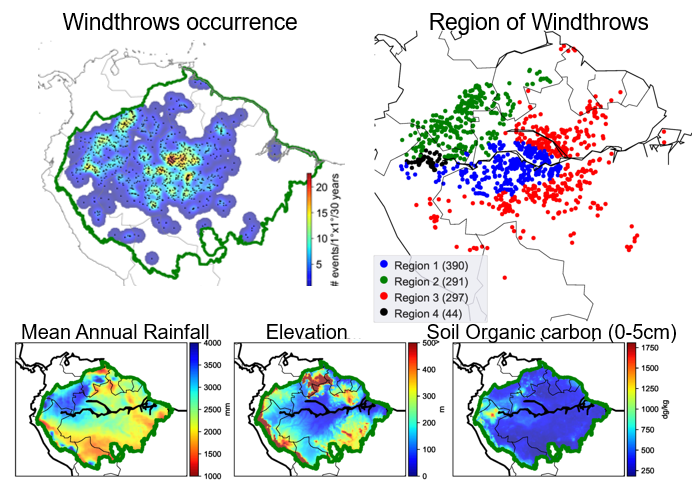Amazon windthrows characteristics driven by environmental variables
The Science
Windthrows (trees uprooted and broken by winds) are common across the Amazon and affect forest dynamics, composition, structure, and carbon balance. Yet, the current understanding of the spatial variability of windthrows is limited. We present the first study to examine the occurrence, area, and direction of windthrows and the control that environmental variables exert on them across the whole Amazon.
The Impact
We found that windthrows are more frequent and larger in the northwestern and the central Amazon. The predominant direction of windthrows is westward. Rainfall, surface elevation, and soil characteristics explain the variability of windthrows but their effects vary regionally. A better understanding of the spatial dynamics of windthrows will improve understanding of the functioning of Amazon forests.
Summary
A total of 392 Landsat 8 images covering the entire Amazon were used and 1116 windthrows were identified based on their shape and spectral characteristics over a 30-year period. Windthrows were integrated with environmental data in a geospatial analysis framework.

Contact
Robinson Negron-Juarez, Lawrence Berkeley National Lab, Staff Scientist (robinson.inj@lbl.gov)
Funding
This study was supported by the Office of Science, Office of Biological and Environmental Research of the US Department of Energy, Agreement grant. DE-AC02-05CH11231, Next Generation Ecosystem Experiments-Tropics, and the Office of Science’s Regional and Global Model Analysis of the US Department of Energy, Agreement grant. DE-AC02-05CH11231, Reducing Uncertainties in Biogeochemical Interactions through Synthesis Computation Scientific Focus Area (RUBISCO SFA).
Publications
Negron-Juarez, R.I., Marra, D., Feng, Y., Urquiza-Muñoz, J.D., Riley, W.J., Chambers, J.Q. Windthrows characteristics and their regional association with rainfall, soil and surface elevation in the Amazon (2022) Environ. Res. Lett. https://doi.org/10.1088/1748-9326/acaf10